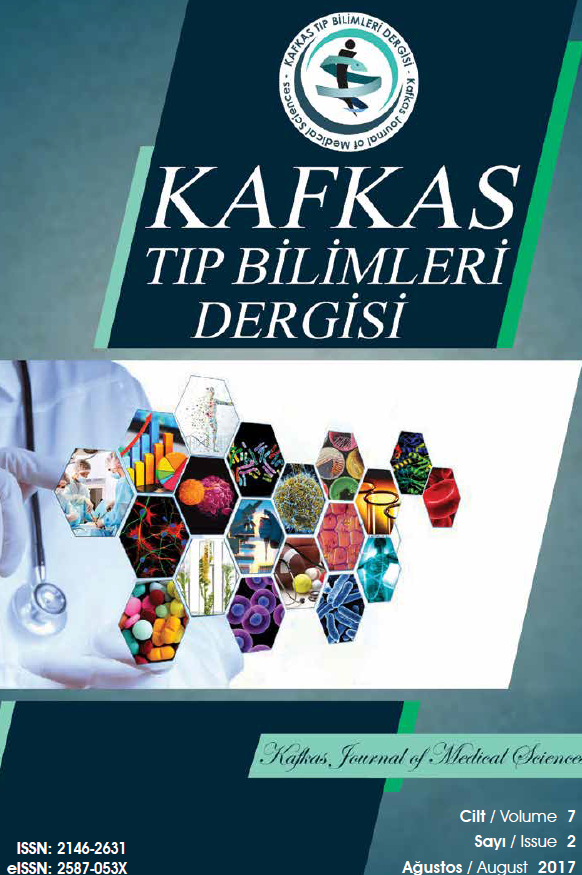Akromiyoklaviküler Eklem Çıkığı Tedavisinde Klavikula Hook Plağı Tekniği ve Fonksiyonel Sonuçları
AMAÇ: Akromiyoklaviküler eklem çıkığının cerrahi tedavi seçenekleri oldukça çeșitlilik göstermektedir. Biz bu yazımızda Tip 3 ve Tip 5 akromiyoklaviküler eklem çıkıklarında klavikula çengel (hook) plağı uyguladığımız olguları ve fonksiyonel sonuçlarını incelemeyi amaçladık. YÖNTEM: Bu retrospektif çalıșmada, aynı teknikle ameliyat edilmiș 24 hastanın verileri incelendi. Veri analizinde, özellikler tanımlayıcı istatistiklerle sunuldu. BULGULAR: İncelediğimiz 24 hastadan 20’si erkek ve dördü kadındı. Akromiyoklaviküler eklem çıkığı olguların 11 tanesi Rockwood Tip 3, 13 tanesi Rockwood Tip 5 eklem çıkığıydı. Tüm hastalar klavikula çengel plağı tekniği ile tedavi edildi. Hastalar ortalama 27,6 ay (6 ay–50 ay) takip edildi ve takip direkt grafi ile yapıldı. Fonksiyonel sonuçlar Constant-Murley omuz skorlaması ile değerlendirildi. Bir hastada enfeksiyon nedeni ile ameliyat sonrası beșinci ayda, bir hastada ise hareket kısıtlılığı nedeni ile ameliyat sonrası üçüncü ayda plak çıkartıldı. Bir olguda ise plağın çengel kısmının kırılması nedeni ile ameliyat sonrası 13. ayda plak çıkartıldı. Diğer hastalarda șikayet olmadı. Dört olguda direkt grafide dejeneratif değișiklikler saptandı. Constant-Murley omuz skorlaması 20 hastada mükemmel (%83,3) ve dört hastada iyi (%16,7) olarak saptandı. SONUÇ: Akromiyoklaviküler eklem çıkığı cerrahi tedavisinde klavikula çengel plağı yöntemi cerrahi açıdan kolay uygulanabilen, implant çıkartılmasına nadiren ihtiyaç duyulan ve fonksiyonel sonuçlar açısından bașarılı bir yöntem gibi gözükmektedir
Clavicle Hook Plate Technique and Its Functional Results in the Treatment of Acromioclavicular Joint Dislocation
AIM: Surgical treatment options of dislocations of acromioclavicular joints vary. We aimed to evaluate the surgical and functional results of clavicle hook plate technique used in our patients suffered from acromioclavicular joint dislocation including Rockwood grade 3 and 5 injuries. METHODS: In this retrospective study, the records of 24 patients, operated with the same technique were evaluated. During data analysis, the characteristics were presented with descriptive statistics. RESULTS: There were 20 male and 4 female patients. Rockwood grade 3 and 5 injuries were seen in 11 and 13 patients, respectively, and all of them were treated by using clavicle hook plaque technique. The mean follow up time was 27.6 (6-50) months by using direct X ray graph. The functional results were evaluated using Constant-Murley scores. The plates were removed from a patient complicated with infection and another patient with movement limitation in the postoperative fi fth and third months, respectively. In addition, one of the plates was removed at the thirteenth month after one portion of the plate was broken. The rest of the patients were without any complaint. We demonstrated degenerative changes in the X- rays of four patients. Constant – Murley shoulder score was perfect in 20 (83.3%) patients and good in 4 (16.7%) patients. CONCLUSION: Clavicle hook plate technique used in the surgical management of acromioclavicular joint dislocations seems easy to apply and has favorite outcomes with a low incidence of obligatory removal.
